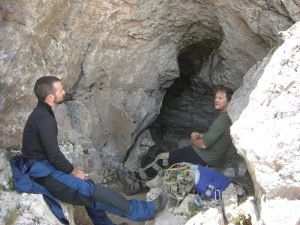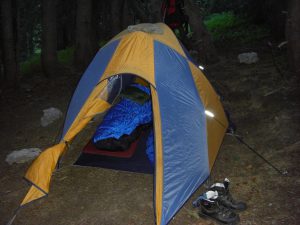Spanish Cave

The first weekend of August, Pete Bronski and I headed up into the mountains to visit the much ballyhooed Spanish Cave. Rumors of Spanish gold and forced slavery have surround this cave, but over the years, all of these have been shown false. Nevertheless, the cave has earned a reputation for being tremendously dangerous and intensely cold with bone-chilling winds. Given these realities and the need for some technical ropework within the cave, we were both quite happy to be teaming up with a couple of other experienced cavers, Randy Macan and Paul Mozal.
Paul was planning to head up to the campsite the previous evening, and Randy would join us late Friday night after driving all the way from Fort Collins. Pete and I left Boulder at around 8:00 in the morning and we had a relaxing 4-hour drive before we started the hike towards the cave. Not long after hitting the 4WD portion of South Colony Lakes Road, we found the parking pullout. We grabbed a little lunch before hefting on our packs and beginning the hike. The hike began on well marked trails, but we quickly turned off onto a climber’s trail. After losing the trail a couple of times and debating our route, we popped out of the trees and made a bee-line for the limestone.
Finding the entrance to Spanish Cave was pretty easy, but locating the campsite proved much harder. It turns out we were way too high on the mountain, yet we didn’t want to lose altitude because we knew we’d have to hike back up in the morning. This caused us to spend a couple of hours zig-zagging through scree and brush looking for a campsite, but there was nothing to be found. The slope of the mountain was far too steep to yield a comfortable resting spot. We tried yelling for Paul and got a response, but it was from somewhere very far off in the distance. Desperate, we headed lower and sure enough we found a delightful little meadow with a large collection of bones. We tried Paul one more time, and the response was much closer. After hefting our packs once more, we were quickly united with him in a small clearing just far enough into the trees to have been invisible from farther up on the mountain.

At this point, we set up our shelter and broke open the food and beer. I was delighted to learn while packing for this trip that New Belgium had just started putting Fat Tire into cans. This was quite the stroke of good fortune for backpacking. After several hours of eating, drinking, chatting, and relaxing we finally heard from Randy as he was making his way towards the camp under the cover of darkness. A few cell phone calls and a round or two fired into the air and Randy came bounding down the trail into camp. Not long thereafter, we went to sleep.

The next morning we all slept in and were a bit lazy. Because the cave was only a few hundred vertical feet above camp, even a long trip wouldn’t require a super early start. After everyone got up, ate breakfast, and double-checked all of the caving gear, we grabbed our packs and headed up to find the upper entrance, Frank’s Nasty Pit. Paul was hiking with the aid of an adventure umbrella for shade. Looking back down the hill as he trailed behind us, it was a bit as though Eliza from My Fair Lady was along on the trip. Paul would end up taking the umbrella along on the trip through the cave and of course it would break. If you think you need a caving umbrella, definitely choose the Go-Lite model. They replaced the broken umbrella with no questions asked! After a few more minutes, we located the upper entrance to the Spanish Cave system. Frank’s Nasty Pit is pretty small, and Paul was a bit worried that I wouldn’t fit into the cave. We had all donned vertical gear in anticipation of the rappel immediately beyond the entrance, but I ended up taking off my harness just in case the entrance proved too tight. That proved to be unnecessary, and putting the harness back on in the tight little room was extra challenging. After a short little drop, we regrouped in the registry room and prepared for the big rappel. This one used about 200 feet of static line with about half of the drop being a free-hanging rappel. At the bottom of the rappel, we stripped off the vertical gear and stowed it into our packs. If all went well, we would emerge from the lower entrance and hike back up to Frank’s Nasty Pit to retrieve the ropes.
The initial cave passage was rather warm. Although it was already the first weekend of August, the lower cave entrance had just recently melted out of the snow. It was a hot day, and a strong wind was traveling in through the upper entrance and exiting via the lower entrance. We knew from our scouting trip the day before that the air leaving Spanish Cave was exceptionally cold, so we expected things to get much colder soon.
Of the 4 of us, Paul was the only one to have made the Spanish Cave through trip; however, he had never traversed the cave in this direction. It turned out that we had a relatively easy trip through the cave, in terms of route finding, but several dangerous moves were required. Most of the caving was difficult, but reasonably secure. We also lucked out in discovering that the ice which typically forms just inside the lower Spanish Cave entrance was essentially non-existent. This made one very dangerous traverse much less risky. On the way out of the cave, I used a small Brunton Weather Station to record the temperature of the cave. The indicator was still dropping when I started to become hypothermic, so I wedged the strat into the ceiling, crawled towards the exit, and left the thermometer behind to equilabrate. About 15 minutes later, with nice warm hands, I crawled back into the cave and retrieved the digital thermometer. About 34 degrees Farenheit! I wasn’t able to get a wind speed reading as the vane had frozen in place, but it was blowing pretty swiftly. I’m certain the wind chill would have dropped the apparent temperature far lower.
It would have been nice to crash back at the campsite and relax, but unfortunately Pete and I both had to be back early on Sunday. Therefore, we packed up camp and again shouldered our heavy packs. We were pretty tired, but we timed the hike about right and reached the Jeep just as things were beginning to get too dark to hike without fetching headlamps from our packs. Despite losing the trail a couple of times and having to negotiate a couple of stream crossings, the hike down was pretty easy and quick. It felt great to put on some dry socks and shoes and eat a few more calories before driving back to Boulder.